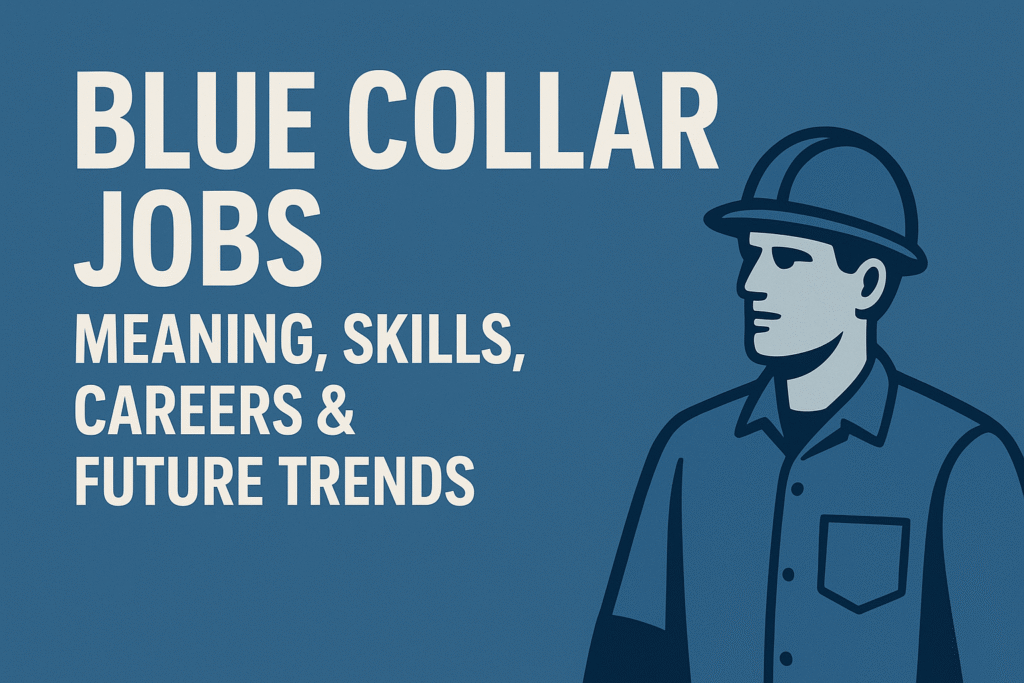Blue-collar workers build bridges, wire cities, drive goods across continents, and keep machines humming. Long before corporate towers and digital dashboards, these trades formed the backbone of every thriving economy. Even in today’s knowledge-driven marketplace, physical work, craftsmanship, and field expertise remain indispensable.
This guide explores the full spectrum of blue-collar employment—its meaning, defining traits, contributions to growth, and how technology, diversity, and engagement reshape its future.
1. What Is Blue Collar?
The phrase “blue collar” dates back to the early 1900s when factory and rail workers commonly wore sturdy, dark blue denim or chambray shirts. The color masked dirt and oil better than white fabrics and became symbolic of manual, industrial, and technical occupations.
In modern usage, blue collar describes jobs that:
- Involve hands-on physical or mechanical work rather than primarily desk-based tasks
- May be hourly wage or salaried, but compensation is tied to shifts, projects, or production output
- Span industries like construction, manufacturing, energy, transport, logistics, and skilled trades
Unlike white-collar roles that focus on administration or analysis, blue-collar careers prioritize production, installation, repair, and tangible output. Yet the distinction is less rigid than before—many skilled trades now integrate advanced technology, digital diagnostics, and supervisory tasks once associated with office roles.
2. Key Characteristics of Blue Collar Jobs
While industries differ, certain traits consistently define blue-collar employment:
- Physical or Technical Core – Work frequently requires lifting, assembling, operating tools, or troubleshooting equipment.
- Skills Acquired Through Practice – Mastery often comes from apprenticeships, trade schools, and certifications rather than four-year academic degrees.
- Shift-Based Schedules – Day, night, rotating, and weekend shifts are common, particularly in plants, utilities, and logistics.
- Structured Hierarchies – Foremen, crew leads, or site supervisors guide day-to-day operations.
- Union Presence – Many sectors have robust labor organizations ensuring fair wages, benefits, and dispute resolution.
- Immediate, Visible Output – Buildings erected, engines repaired, freight delivered—success is concrete, not abstract.
3. Why Skills and Safety Are Paramount
Blue-collar industries deal with machinery, electrical systems, chemicals, and heavy loads. Mistakes can be costly or dangerous, making skill competency and strict adherence to safety protocols non-negotiable.
- Skill Development – From blueprint reading to hydraulic diagnostics, expertise evolves with experience and ongoing training.
- Regulatory Compliance – Standards from OSHA, ISO, and local authorities govern protective equipment, site procedures, and hazard reporting.
- Safety Culture – Toolbox talks, hazard assessments, lockout/tagout procedures, and incident drills foster vigilance.
An investment in training and PPE not only saves lives but reduces downtime, liability, and turnover, giving firms a measurable productivity edge.
4. Blue Collar Jobs in the Modern Economy
Despite narratives about “disappearing” trades, demand remains robust. Consider:
- Construction & Infrastructure – Roads, housing, and public transit need carpenters, crane operators, welders, and concrete finishers.
- Energy & Utilities – Electric grid upgrades, solar farms, wind turbines, and pipeline maintenance depend on skilled technicians.
- Transportation & Logistics – Global e-commerce relies on truck drivers, dockworkers, warehouse staff, and equipment operators.
- Advanced Manufacturing – Robotics assembly, precision machining, and additive manufacturing mix traditional craftsmanship with digital controls.
Emerging “green-collar” opportunities—solar installers, EV charging specialists, and energy auditors—further expand the scope of manual-technical work.
5. Why Blue Collar Workers Are Crucial to Organizational Success
- Operational Backbone – A logistics firm can’t deliver without drivers; a utility company can’t serve customers without line workers.
- Customer Trust – Service reliability depends on technicians who install correctly, repair swiftly, and communicate clearly.
- Innovation from the Field – Employees closest to the equipment often spot inefficiencies first, spurring process improvements.
- Brand Reputation – Safety incidents or quality failures trace back to operational diligence—handled by frontline crews.
Enterprises that neglect this workforce risk production delays, service interruptions, and reputational harm.
6. Representative List of Blue Collar Jobs
Blue-collar employment spans far more than construction sites or assembly lines. From public utilities to transportation and precision manufacturing, these roles form the practical backbone of modern life.
A clear understanding of the many occupations that fall under the “blue collar” umbrella helps job seekers, HR teams, and policymakers appreciate the diversity of skills involved. Below is a representative—though by no means exhaustive—list of blue-collar careers across key industries, highlighting the breadth of technical and hands-on expertise that keeps economies running.
| Sector | Common Roles |
| Construction | Carpenter, mason, steel erector, crane operator |
| Manufacturing | Machinist, CNC operator, assembly line worker |
| Transportation | Long-haul trucker, delivery driver, railway technician |
| Utilities & Energy | Lineman, wind turbine tech, solar panel installer |
| Maintenance & Repair | Auto mechanic, HVAC specialist, elevator technician |
| Public Works | Sanitation worker, road maintenance crew, water treatment operator |
This is far from exhaustive—hospitality, agriculture, and mining each contain multiple blue-collar subcategories.
7. Work Environment
Workplaces range from construction sites under open skies to climate-controlled factories or on-the-road trucking cabins. Noise, dust, and physical exertion may be routine, but employers increasingly provide:
- Ergonomic tools and lifting aids
- Rest and hydration schedules
- Climate-appropriate gear (insulated coveralls, cooling vests)
- Clear signage and hazard zoning
Collaboration is central; team cohesion and communication directly influence safety and project success.
8. Primary Duties
Across trades, duties commonly include:
- Reading technical drawings, schematics, or digital instructions
- Setting up and calibrating machines, hand tools, or vehicles
- Performing inspections, diagnostics, and preventive maintenance
- Recording material usage, hours, or production data for supervisors
- Coordinating with other departments (procurement, engineering, QA)
Accountability is clear: errors can halt production or create safety liabilities.
9. Education Pathways and Skill Requirements
While some entry-level roles accept a high school diploma or GED, competitive positions often expect:
- Vocational Programs – Welding technology, automotive repair, electrical fundamentals
- Apprenticeships – Paid, multi-year programs blending on-site mentorship with classroom instruction
- Certifications & Licenses – CDL (commercial driving license), EPA HVAC certification, OSHA safety cards, state electrician licenses
Soft skills matter too: adaptability, teamwork, time management, and situational awareness enhance career longevity.
10. Practical Examples
- Plumber – Installs piping, fixes leaks, ensures water safety in homes and industry.
- Industrial Welder – Fuses structural steel, pipelines, or pressure vessels, requiring precision and metallurgical knowledge.
- Heavy Equipment Operator – Maneuvers bulldozers, loaders, and cranes with split-second judgment.
- Warehouse Picker/Packer – Ensures accurate, efficient order fulfillment in supply chains.
Each illustrates problem-solving under real-world constraints—timelines, materials, and safety all converge on daily decision-making.
11. Salary Outlook and Earning Potential
Wages vary with region, union contracts, and experience:
- Entry Level – $18–$22/hour in many U.S. markets
- Mid-Career Tradesperson – $50,000–$70,000/year, with overtime premiums
- High-Specialty Roles – Power line technicians, elevator installers, or offshore rig workers can surpass $90,000 annually
- Benefits – Health insurance, pensions, paid training, and shift differentials enhance total compensation
Importantly, many trades have shorter educational tracks and less student debt compared with four-year college paths.
12. Blue Collar vs. Other “Collars”
The term “collar jobs” categorizes workforces by the nature of their duties, attire, and industry roots. While the labels are informal, they help describe broad employment groups:
| Category | Typical Work | Education | Compensation Basis |
| Blue | Manual/technical | Apprenticeship, trade school | Hourly/project |
| White | Administrative/professional | Bachelor’s/graduate degrees | Salary |
| Pink | Care/service (nursing, teaching) | Varies | Hourly/salary |
| Green | Renewable energy/environment | Technical + environmental | Mix |
| Gold | Highly specialized tech/professional | Advanced | Premium salary |
These labels blur as hybrid roles (e.g., mechatronics technicians) combine manual dexterity with coding or analytics.
13. Myths and Misconceptions
- Myth: “No career progression.” Reality: Journeyman → Foreman → Supervisor → Business owner.
- Myth: “Low intellectual demand.” Precision welding or PLC troubleshooting requires mathematics, spatial reasoning, and critical thinking.
- Myth: “Automation will wipe out jobs.” Machines still need programming, calibration, and human oversight.
Dispelling these myths attracts younger generations hesitant to consider the trades.
14. Economic Impact
Blue-collar labor fuels GDP: each construction dollar circulates through suppliers, finance, and retail. During economic downturns, infrastructure projects often act as stabilizers, sustaining employment and stimulating local economies. Logistics ensures food, medicine, and goods reach markets, directly influencing consumer confidence and price stability.
15. Technology and Automation
Modern plants deploy robotics, IoT sensors, and predictive analytics. Implications:
- Fewer repetitive, injury-prone tasks
- New job categories: robotic welder operator, maintenance technologist
- Greater need for digital literacy—workers interact with dashboards, diagnostics, and real-time alerts
Upskilling initiatives—online modules, AR training—equip employees to remain indispensable.
16. Job Satisfaction in Blue Collar Roles
Satisfaction stems from:
- Tangible Outcomes – “I built that bridge.”
- Camaraderie – Crews share challenges, fostering strong bonds.
- Clear Contribution – Work directly supports families, neighborhoods, and commerce.
- Stable Income – Predictable wages and overtime potential provide financial security.
Surveys show many skilled tradespeople report equal or higher life satisfaction than some office professionals due to visible accomplishment and minimal desk fatigue.
17. Challenges Today
- Cyclic Demand – Construction ebbs with economic shifts.
- Physical Wear – Strain injuries, long shifts, and exposure hazards.
- Perception Gap – Younger workers pushed toward degrees overlook lucrative trades.
- Access to Training – Rural regions may lack robust apprenticeship programs.
Policy incentives, career awareness campaigns, and ergonomic innovations address these hurdles.
18. Diversity, Equity & Inclusion (DEI)
Historically male-dominated, trades benefit from:
- Inclusive Recruitment – Partnerships with vocational schools serving women and minorities.
- Language Support – Multilingual safety manuals reduce miscommunication.
- Equitable Pay Audits – Ensuring identical wages for identical roles regardless of gender or ethnicity.
DEI drives innovation, morale, and labor availability, critical amid skilled-worker shortages.
19. Employee Engagement Strategies
- Transparent Communication – Shift briefings, mobile alerts, multilingual bulletins.
- Recognition Programs – Safety milestones, attendance awards, skill mastery certificates.
- Continuous Learning – Cross-training, tuition reimbursement, vendor workshops.
- Work-Life Balance – Predictable rosters, fair overtime limits, wellness initiatives.
20. Labor Unions’ Protective Role
Unions negotiate collective bargaining agreements, handle grievances, and secure benefits such as retirement plans, paid leave, and hazard pay. They lobby for fair legislation and training pipelines, stabilizing workforces in volatile markets.
21. Best Practices for HR Teams Engaging Deskless Staff
- Deploy mobile apps for pay slips, policy updates, and instant feedback
- Offer site-level leadership training to supervisors for empathetic, inclusive management
- Use peer mentors to onboard new hires and cut turnover
- Celebrate milestones—work anniversaries, certifications, project completions
22. Power of Employee Pulse Surveys
Short, frequent surveys gauge:
- Morale – Are crews proud, fatigued, motivated?
- Safety Perceptions – Do workers trust protocols?
- Training Needs – Which skills feel outdated?
Actionable data enables HR to close gaps quickly, preventing disengagement before it manifests as attrition.
23. Automation’s Long-Term Impact
Automation redefines—not erases—blue-collar work:
- Collaborative Robots (Cobots) relieve repetitive strain yet require operators, programmers, and troubleshooters.
- Predictive analytics shifts maintenance from reactive to proactive, empowering crews to intervene earlier.
- Training evolves toward hybrid skill sets—mechanical aptitude plus software familiarity.
Result: safer environments, higher productivity, and upskilled, future-proof careers.
Final Thoughts
Blue-collar professions remain indispensable to economic resilience, infrastructure renewal, and societal well-being. As technology permeates shop floors and job sites, the workforce evolves—requiring new competencies but retaining the timeless value of craftsmanship, accountability, and grit. Employers who honor, engage, and continually train their blue-collar teams will secure not only reliable operations but a sustainable competitive advantage in every market cycle.







